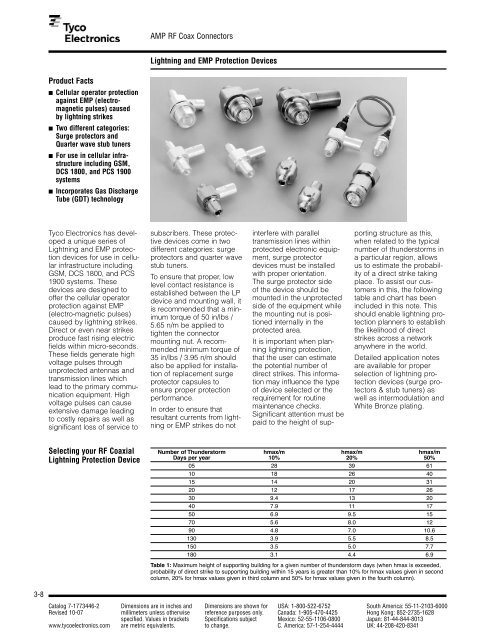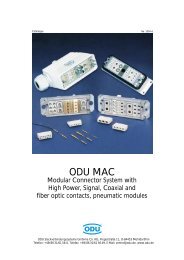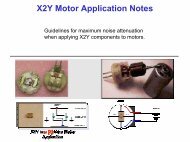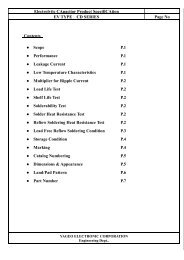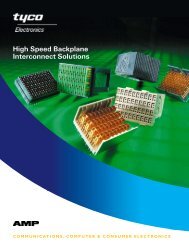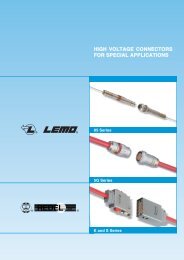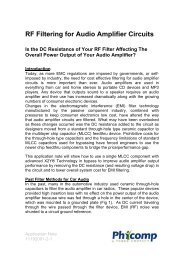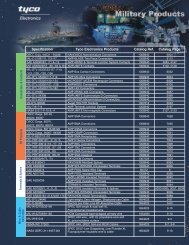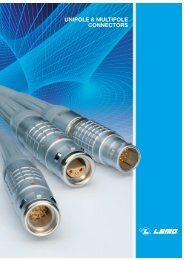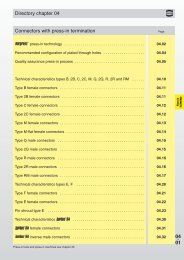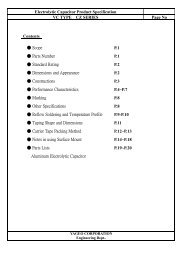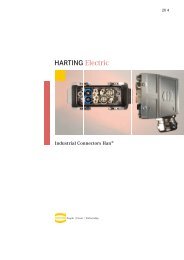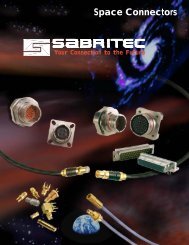3RF Coax Connectors
3RF Coax Connectors
3RF Coax Connectors
Create successful ePaper yourself
Turn your PDF publications into a flip-book with our unique Google optimized e-Paper software.
AMP RF <strong>Coax</strong> <strong>Connectors</strong>Lightning and EMP Protection DevicesProduct Facts■ Cellular operator protectionagainst EMP (electromagneticpulses) causedby lightning strikes■ Two different categories:Surge protectors andQuarter wave stub tuners■ For use in cellular infrastructureincluding GSM,DCS 1800, and PCS 1900systems■ Incorporates Gas DischargeTube (GDT) technologyTyco Electronics has developeda unique series ofLightning and EMP protectiondevices for use in cellularinfrastructure includingGSM, DCS 1800, and PCS1900 systems. Thesedevices are designed tooffer the cellular operatorprotection against EMP(electro-magnetic pulses)caused by lightning strikes.Direct or even near strikesproduce fast rising electricfields within micro-seconds.These fields generate highvoltage pulses throughunprotected antennas andtransmission lines whichlead to the primary communicationequipment. Highvoltage pulses can causeextensive damage leadingto costly repairs as well assignificant loss of service tosubscribers. These protectivedevices come in twodifferent categories: surgeprotectors and quarter wavestub tuners.To ensure that proper, lowlevel contact resistance isestablished between the LPdevice and mounting wall, itis recommended that a minimumtorque of 50 in/lbs /5.65 n/m be applied totighten the connectormounting nut. A recommendedminimum torque of35 in/lbs / 3.95 n/m shouldalso be applied for installationof replacement surgeprotector capsules toensure proper protectionperformance.In order to ensure thatresultant currents from lightningor EMP strikes do notinterfere with paralleltransmission lines withinprotected electronic equipment,surge protectordevices must be installedwith proper orientation.The surge protector sideof the device should bemounted in the unprotectedside of the equipment whilethe mounting nut is positionedinternally in theprotected area.It is important when planninglightning protection,that the user can estimatethe potential number ofdirect strikes. This informationmay influence the typeof device selected or therequirement for routinemaintenance checks.Significant attention must bepaid to the height of supportingstructure as this,when related to the typicalnumber of thunderstorms ina particular region, allowsus to estimate the probabilityof a direct strike takingplace. To assist our customersin this, the followingtable and chart has beenincluded in this note. Thisshould enable lightning protectionplanners to establishthe likelihood of directstrikes across a networkanywhere in the world.Detailed application notesare available for properselection of lightning protectiondevices (surge protectors& stub tuners) aswell as intermodulation andWhite Bronze plating.Selecting your RF <strong>Coax</strong>ialLightning Protection DeviceNumber of Thunderstorm hmax/m hmax/m hmax/mDays per year 10% 20% 50%05 28 39 6110 18 26 4015 14 20 3120 12 17 2630 9.4 13 2040 7.9 11 1750 6.9 9.5 1570 5.6 8.0 1290 4.8 7.0 10.6130 3.9 5.5 8.5150 3.5 5.0 7.7180 3.1 4.4 6.9Table 1: Maximum height of supporting building for a given number of thunderstorm days (when hmax is exceeded,probability of direct strike to supporting building within 15 years is greater than 10% for hmax values given in secondcolumn, 20% for hmax values given in third column and 50% for hmax values given in the fourth column).3-8Catalog 7-1773446-2 Dimensions are in inches and Dimensions are shown for USA: 1-800-522-6752 South America: 55-11-2103-6000Revised 10-07 millimeters unless otherwise reference purposes only. Canada: 1-905-470-4425 Hong Kong: 852-2735-1628specified. Values in brackets Specifications subject Mexico: 52-55-1106-0800 Japan: 81-44-844-8013www.tycoelectronics.com are metric equivalents. to change. C. America: 57-1-254-4444 UK: 44-208-420-8341


